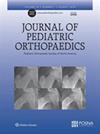Hybrid Fixation for Large Unstable Juvenile Osteochondritis Dissecans Lesions: Midterm Results in Adolescent Patients With Completely or Partially Salvageable Progeny Fragment.
IF 1.4
3区 医学
Q3 ORTHOPEDICS
引用次数: 0
Abstract
BACKGROUND This study aimed to describe the midterm clinical and radiographic outcomes of a hybrid fixation technique (HFT) combining interfragmentary compression with screws and biological support provided by the osteochondral autograft transplantation system (OATS) for treating large unstable juvenile osteochondritis dissecans (JOCD) lesions involving the knee in patients aged ≤18 years. METHODS Thirteen patients (15 knees, 9 males) with unstable JOCD lesions in the knee underwent treatment. HFT was indicated for lesions that had a completely salvageable (N=10) or partially salvageable progeny fragment (N=5). Patients were evaluated at a minimum follow-up of 1 year. The mean age of the patients was 15.3 years (range, 11 to 18 y), with 10 lesions involving the medial femoral condyle and 5 involving the lateral femoral condyle. The mean lesion area were 397.7 mm2. The outcome measures included the Pedi-IKDC and Tegner activity scales. Radiographic evaluation consisted of assessing osteochondral graft integration using the MOCART score on MRI and determining the degree of osteoarthritis using the Kellgren-Lawrence system (KL). RESULTS At a mean follow-up of 51 months (range, 12 to 143 mo), the mean Pedi-IKDC and Tegner activity scale were 90.1±7.2 and 94.7±6.7 points, respectively. Patients with unilateral lesions resumed sports activities on average after 7.7 months (range, 6 to 12 mo). All patients exhibited progeny fragment integration on MRI, with a mean MOCART score of 85±6.5 (range, 75 to 95). Radiographs indicated grade 1 KL joint space in 13 knees and grade 2 in 2 knees. At the last follow-up, 12 patients were asymptomatic, whereas 1 patient experienced occasional mild discomfort during intense physical activity. Six patients required additional surgery for hardware removal, and 1 patient underwent intra-articular loose body removal. CONCLUSION The hybrid fixation technique showed promising outcomes in terms of fragment healing and midterm results for unstable JOCD lesions. These findings suggest that HFT can be considered a valid treatment option for large unstable lesions involving the femoral condyles of the knee in adolescents. STUDY DESIGN Therapeutic study (level of evidence IV).混合固定治疗大面积不稳定的幼年骨软骨发育不全病变:青少年患者完全或部分可挽救后代片段的中期结果。
背景本研究旨在描述一种混合固定技术(HFT)的中期临床和放射学结果,该技术结合了用螺钉进行节段间加压和骨软骨自体移植系统(OATS)提供的生物支持,用于治疗年龄小于 18 岁的膝关节大面积不稳定幼年骨软骨炎(JOCD)病变。方法13 位膝关节不稳定 JOCD 病变患者(15 个膝关节,9 位男性)接受了治疗。HFT适用于完全可挽救(10例)或部分可挽救(5例)的病变原发片段。对患者进行了至少 1 年的随访评估。患者的平均年龄为15.3岁(11至18岁),其中10例病变累及股骨内侧髁,5例累及股骨外侧髁。平均病变面积为 397.7 平方毫米。结果测量包括 Pedi-IKDC 和 Tegner 活动量表。结果平均随访51个月(12至143个月),Pedi-IKDC和Tegner活动量表的平均值分别为90.1±7.2分和94.7±6.7分。单侧病变患者平均在 7.7 个月后(6 至 12 个月)恢复体育活动。所有患者在核磁共振成像上都显示出原发片段整合,平均MOCART评分为85±6.5分(范围为75至95分)。X光片显示,13个膝关节的KL关节间隙为1级,2个膝关节为2级。在最后一次随访中,12名患者无症状,1名患者在剧烈运动时偶尔出现轻微不适。结论 混合固定技术在不稳定的 JOCD 病变的片段愈合和中期效果方面显示出良好的结果。这些研究结果表明,对于涉及青少年膝关节股骨髁的巨大不稳定病变,HFT可被视为一种有效的治疗方案。
本文章由计算机程序翻译,如有差异,请以英文原文为准。
求助全文
约1分钟内获得全文
求助全文
来源期刊
CiteScore
3.30
自引率
17.60%
发文量
512
审稿时长
6 months
期刊介绍:
Journal of Pediatric Orthopaedics is a leading journal that focuses specifically on traumatic injuries to give you hands-on on coverage of a fast-growing field. You''ll get articles that cover everything from the nature of injury to the effects of new drug therapies; everything from recommendations for more effective surgical approaches to the latest laboratory findings.

 求助内容:
求助内容: 应助结果提醒方式:
应助结果提醒方式:


